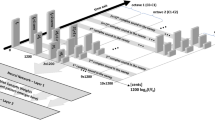Abstract
A new theory of musical tonality is explored, which treats the central auditory pathway as a complex nonlinear dynamical system. The theory predicts that as networks of neural oscillators phase-lock to musical stimuli, stability and attraction relationships will develop among frequencies, and these dynamic forces correspond to perceptions of stability and attraction among musical tones. This paper reports on an experiment with learning in a model auditory network. Results suggest that Hebbian synaptic modification can change the dynamic responses of the network in some ways but not in others.
Access this chapter
Tax calculation will be finalised at checkout
Purchases are for personal use only
Preview
Unable to display preview. Download preview PDF.
Similar content being viewed by others
References
Zuckerkandl, V.: Sound and Symbol: Music and the External World. Princeton University Press, Princeton (1956)
Large, E.W., Tretakis, A.E.: Tonality and Nonlinear Resonance. In: Avanzini, G., Lopez, L., Koelsch, S., Majno, M. (eds.) The Neurosciences and Music II: From Perception to Performance. Annals of the New York Academy of Sciences, vol. 1060, pp. 53–56 (2005)
Shapira Lots, I., Stone, L.: Perception of musical consonance and dissonance: an outcome of neural synchronization. Journal of The Royal Society Interface 5(29), 1429–1434 (2008)
Large, E.W.: A dynamical systems approach to musical tonality. In: Huys, R., Jirsa, V.K. (eds.) Nonlinear Dynamics in Human Behavior. Studies in Computational Intelligence, vol. 328, pp. 193–211. Springer, Heidelberg (2010)
Lerdahl, F.: Tonal Pitch Space. Oxford University Press, New York (2001)
Larson, S.: Musical forces and melodic expectations: Comparing computer models and experimental results. Music Percept 21(4), 457–498 (2004)
Bharucha, J.J.: Anchoring effects in music: The resolution of dissonance. Cogn. Psychol. 16, 485–518 (1984)
Burns, E.M.: Intervals, scales, and tuning. In: Deustch, D. (ed.) The Psychology of Music, pp. 215–264. Academic Press, San Diego (1999)
Ohm, G.S.: Uber die Denition des Tones, nebst daran geknufter Theorie der Sirene und ahnlicher tonbildender Vorichtungen. Ann. Phys. Chem. 135(8), 513–565 (1843)
Helmholtz, H.L.F.: On the sensations of tone as a physiological basis for the theory of music. Dover Publications, New York (1863)
Plomp, R., Levelt, W.J.M.: Tonal consonance and critical bandwidth. J. Acoust. Soc. Am. 38, 548–560 (1965)
Kameoka, A., Kuriyagawa, M.: Consonance theory part II: Consonance of complex tones and its calculation method. J. Acoust. Soc. Am. 45, 1460–1471 (1969)
Dowling, W.J., Harwood, D.L.: Music Cognition. Academic Press, San Diego (1986)
Krumhansl, C.L.: Cognitive foundations of musical pitch. Oxford University Press, NY (1990)
Cuddy, L.L., Lunney, C.A.: Expectancies generated by melodic intervals: Perceptual judgements of melodic continuity. P&P 57, 451–462 (1995)
Schellenberg, E.G.: Expectancy in melody: Tests of the implication realization model. Cognition 58, 75–125 (1996)
Knopoff, L., Hutchinson, W.: An index of melodic activity. Interface 7, 205–229 (1978)
Temperley, D.: The cognition of basic musical structures. MIT Press, Cambridge (2001)
Pearce, M.T., Wiggins, G.A.: Expectation in Melody: The Influence of Context and Learning. Music Perception 23(5), 377–405 (2006)
Eguìluz, V.M., Ospeck, M., Choe, Y., Hudspeth, A.J., Magnasco, M.O.: Essential nonlinearities in hearing. PhRvL 84(22), 5232 (2000)
Langner, G.: Periodicity coding in the auditory system. Hear. Res. 60, 115–142 (1992)
Joris, P.X., Schreiner, C.E., Rees, A.: Neural Processing of Amplitude-Modulated Sounds. Physiol. Rev. 84(2), 541–577 (2004)
Escabi, M.A., Schreiner, C.E.: Nonlinear Spectrotemporal Sound Analysis by Neurons in the Auditory Midbrain. J. Neurosci. 22(10), 4114–4131 (2002)
Langner, G.: Temporal processing of periodic signals in the auditory system: Neuronal representation of pitch, timbre, and harmonicity. Z. Audiol. 46(1), 80–21 (2007)
Sutter, M.L., Schreiner, C.: Physiology and topography of neurons with multipeaked tuning curves in cat primary auditory cortex. J. Neurophysiol. 65(5), 1207–1226 (1991)
Lee, K.M., Skoe, E., Kraus, N., Ashley, R.: Selective Subcortical Enhancement of Musical Intervals in Musicians. J. Neurosci. 29(18), 5832–5840 (2009)
Zhang, J., Harbottle, G., Wang, C., Kong, Z.: Oldest playable musical instruments found at Jiahu early Neolithic site in China. Nature 401, 366–368 (1999)
Large, E.W., Almonte, F., Velasco, M.: A canonical model for gradient frequency neural networks. Physica D: Nonlinear Phenomena 239(12), 905–911 (2010)
Hoppensteadt, F.C., Izhikevich, E.M.: Weakly Connected Neural Networks. Springer, New York (1997)
Wilson, H.R., Cowan, J.D.: A mathematical theory of the functional dynamics of cortical and thalamic nervous tissue. Kybernetik 13, 55–80 (1973)
Large, E.W., Almonte, F.: Phase-locked neural oscillation predicts human auditory brainstem responses to musical intervals. PNAS Under Review (2011)
Krumhansl, C.L., Kessler, E.J.: Tracing the dynamic changes in perceived tonal organization in a spatial representation of musical keys. Psychol. Rev. 89(4), 334–368 (1982)
Hoppensteadt, F.C., Izhikevich, E.M.: Synaptic organizations and dynamical properties of weakly connected neural oscillators II: Learning phase information. Biol. Cybern. 75, 126–135 (1996)
Duke, T., Julicher, F.: Active traveling wave in the cochlea. PhRvL 90(15), 158101 (2003)
Kern, A., Stoop, R.: Essential role of couplings between hearing nonlinearities. Phys. Rev. Lett. 91(12), 128101–128104 (2003)
Prince, A., Smolensky, P.: Optimality: From Neural Networks to Universal Grammar. Science 275, 1604–1610 (1997)
Author information
Authors and Affiliations
Editor information
Editors and Affiliations
Rights and permissions
Copyright information
© 2011 Springer-Verlag Berlin Heidelberg
About this paper
Cite this paper
Large, E.W. (2011). Musical Tonality, Neural Resonance and Hebbian Learning. In: Agon, C., Andreatta, M., Assayag, G., Amiot, E., Bresson, J., Mandereau, J. (eds) Mathematics and Computation in Music. MCM 2011. Lecture Notes in Computer Science(), vol 6726. Springer, Berlin, Heidelberg. https://doi.org/10.1007/978-3-642-21590-2_9
Download citation
DOI: https://doi.org/10.1007/978-3-642-21590-2_9
Publisher Name: Springer, Berlin, Heidelberg
Print ISBN: 978-3-642-21589-6
Online ISBN: 978-3-642-21590-2
eBook Packages: Computer ScienceComputer Science (R0)




